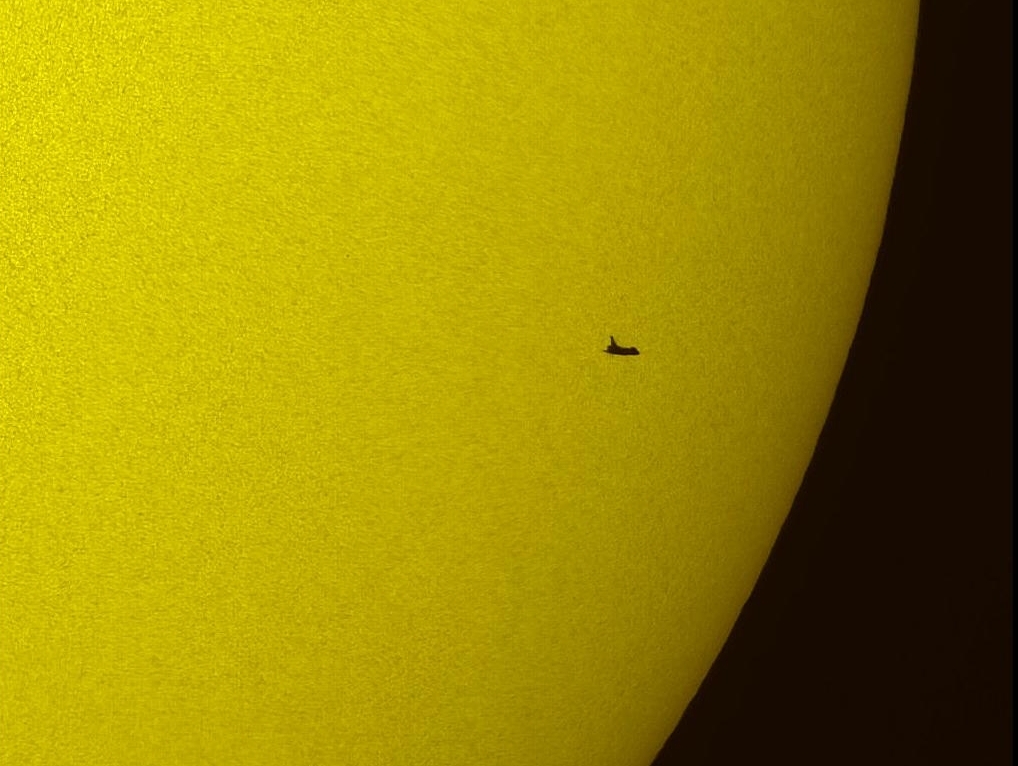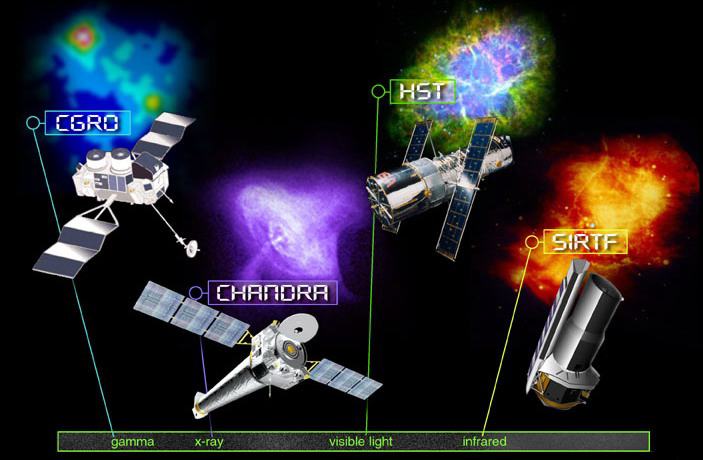|
STS-37
STS-37, the thirty-ninth NASA Space Shuttle mission and the eighth flight of the Space Shuttle ''Atlantis'', was a six-day mission with the primary objective of launching the Compton Gamma Ray Observatory (CGRO), the second of the Great Observatories program which included the visible-spectrum Hubble Space Telescope (HST), the Chandra X-ray Observatory (CXO) and the infrared Spitzer Space Telescope. The mission also featured two spacewalks, the first since 1985. Crew Spacewalks ;EVA 1 * Personnel: Apt and Ross * Date: April 7, 1991 (≈18:00–22:00 UTC) * Duration: 4 hours, 32 minutes ;EVA 2 * Personnel: Apt and Ross * Date: April 8, 1991 (14:51–20:38 UTC) * Duration: 5 hours, 57 minutes Crew seat assignments Preparations and launch The STS-37 mission was successfully launched from launch pad 39B at 9:22:44 a.m. EST on April 5, 1991, from the Kennedy Space Center in Florida. Resumption of the countdown after the T−9-minute hold was del ... [...More Info...] [...Related Items...] OR: [Wikipedia] [Google] [Baidu] [Amazon] |
Jerome Apt
Jerome "Jay" Apt III (born April 28, 1949) is an American astronaut and professor at Carnegie Mellon University. Before becoming an astronaut, Apt was a physicist who worked on the Pioneer Venus 1978 space probe project, and used visible light and infrared techniques to study the planets and moons of the Solar System from ground-based observatories. Biography Apt was a resident of Shadyside and graduated from Shady Side Academy in Pittsburgh, Pennsylvania, in 1967.Spacefacts Biography of Jerome Apt ''Spacefacts''. Retrieved July 18, 2011. He went on to attend , earning a |
Compton Gamma Ray Observatory
The Compton Gamma Ray Observatory (CGRO) was a space observatory detecting photons with photon energy, energies from 20 kElectronvolt#Properties, eV to 30 GeV, in Earth orbit from 1991 to 2000. The observatory featured four main telescopes in one spacecraft, covering X-rays and gamma rays, including various specialized sub-instruments and detectors. Following 14 years of effort, the observatory was launched from Space Shuttle Atlantis, Space Shuttle ''Atlantis'' during STS-37 on April 5, 1991, and operated until its Atmospheric entry#Deorbit disposal, deorbit on June 4, 2000. It was deployed in low Earth orbit at to avoid the Van Allen radiation belt. It was the heaviest astrophysical payload ever flown at that time at . Costing $617 million, the CGRO was part of NASA's Great Observatories program, Great Observatories series, along with the Hubble Space Telescope, the Chandra X-ray Observatory, and the Spitzer Space Telescope. It was the second of the series to ... [...More Info...] [...Related Items...] OR: [Wikipedia] [Google] [Baidu] [Amazon] |
Shuttle Amateur Radio Experiment
The Shuttle Amateur Radio Experiment (SAREX), later called the Space Amateur Radio Experiment, was a program that promoted and supported the use of amateur ("ham") radio by astronauts in low Earth orbit aboard the United States Space Shuttle to communicate with other amateur radio stations around the world. It was superseded by the Amateur Radio on the International Space Station (ARISS) program. SAREX was sponsored by NASA, AMSAT (The Radio Amateur Satellite Corporation), and the ARRL (American Radio Relay League). History Shortly after the launch of STS-9, On November 28, 1983 Owen Garriott (W5LFL) became the first amateur radio operator active in space. Garriott had already flown on Skylab 3, but did not operate radio equipment on that trip. On STS-9, he used a handheld 2-meter radio, provided by the Motorola Amateur Radio Club in Fort Lauderdale, to talk to his mother, senator Barry Goldwater (K7UGA), King Hussein of Jordan (JY1), and many others. Garriott made approximat ... [...More Info...] [...Related Items...] OR: [Wikipedia] [Google] [Baidu] [Amazon] |
Space Shuttle Atlantis
Space Shuttle ''Atlantis'' (Orbiter Vehicle designation: OV‑104) is a retired Space Shuttle orbiter vehicle which belongs to NASA, the spaceflight and space exploration agency of the United States. ''Atlantis'' was manufactured by the Rockwell International company in Southern California and was delivered to the Kennedy Space Center in Eastern Florida in April 1985. ''Atlantis'' is the fourth operational and the second-to-last Space Shuttle built. Its maiden flight was STS-51-J made from October 3 to 7, 1985. ''Atlantis'' embarked on its 33rd and final mission, also the final mission of a space shuttle, STS-135, on July 8, 2011. STS-134 by Space Shuttle Endeavour, ''Endeavour'' was expected to be the final flight before STS-135 was authorized in October 2010. STS-135 took advantage of the processing for the STS-335 Launch on Need mission that would have been necessary if STS-134's crew became stranded in orbit. ''Atlantis'' landed for the final time at the Kennedy Space Cent ... [...More Info...] [...Related Items...] OR: [Wikipedia] [Google] [Baidu] [Amazon] |
NASA
The National Aeronautics and Space Administration (NASA ) is an independent agencies of the United States government, independent agency of the federal government of the United States, US federal government responsible for the United States's civil list of government space agencies, space program, aeronautics research and outer space, space research. National Aeronautics and Space Act, Established in 1958, it succeeded the National Advisory Committee for Aeronautics (NACA) to give the American space development effort a distinct civilian orientation, emphasizing peaceful applications in space science. It has since led most of America's space exploration programs, including Project Mercury, Project Gemini, the 1968–1972 Apollo program missions, the Skylab space station, and the Space Shuttle. Currently, NASA supports the International Space Station (ISS) along with the Commercial Crew Program and oversees the development of the Orion (spacecraft), Orion spacecraft and the Sp ... [...More Info...] [...Related Items...] OR: [Wikipedia] [Google] [Baidu] [Amazon] |
Great Observatories Program
NASA's series of Great Observatories satellites are four large, powerful space telescope, space-based astronomical telescopes launched between 1990 and 2003. They were built with different technology to examine specific wavelength/energy regions of the electromagnetic spectrum: gamma rays, X-rays, Visible light, visible and ultraviolet light, and Infrared, infrared light. The Hubble Space Telescope (HST) primarily observes optical spectrum, visible light and Near ultraviolet, near-ultraviolet. It was launched in 1990 aboard the Space Shuttle Discovery, Space Shuttle ''Discovery'' during STS-31, but its main mirror had been ground incorrectly, resulting in spherical aberration that compromised the telescope's capabilities. The optics were corrected to their intended quality by the STS-61 servicing mission in 1993. In 1997, the STS-82 servicing mission added capability in the Near infrared, near-infrared range, and in 2009 the STS-125 servicing mission refurbished the telescope an ... [...More Info...] [...Related Items...] OR: [Wikipedia] [Google] [Baidu] [Amazon] |
Kennedy Space Center Launch Complex 39B
Launch Complex 39B (LC-39B) is the second of Launch Complex 39's three launch pads, located at NASA's Kennedy Space Center in Merritt Island, Florida. The pad, along with Launch Complex 39A, was first designed for the Saturn V launch vehicle, which at the time was the United States' most powerful rocket. Typically used to launch NASA's crewed spaceflight missions since the late 1960s, the pad is currently configured for use by the agency's Space Launch System rocket, a Shuttle-derived launch vehicle which is currently used in the Artemis program and subsequent Moon to Mars campaigns. The pad had also been leased by NASA to aerospace company Northrop Grumman, for use as a launch site for their Shuttle-derived OmegA launch vehicle, for National Security Space Launch flights and commercial launches, before the OmegA program was cancelled. History Apollo program In 1961, President Kennedy proposed to Congress the goal of landing a man on the Moon by the end of the decade. Congre ... [...More Info...] [...Related Items...] OR: [Wikipedia] [Google] [Baidu] [Amazon] |
STS-39
STS-39 was the twelfth mission of the NASA Space Shuttle ''Discovery'', and the 40th orbital shuttle mission overall. The primary purpose of the mission was to conduct a variety of payload experiments for the U.S. Department of Defense (DoD). Crew Crew seat assignments Mission highlights Launch was originally scheduled for March 9, 1991, but during processing work at Pad LC-39A, significant cracks were found on all four lug hinges on the two external tank umbilical door drive mechanisms. NASA managers opted to roll back the vehicle to the Vehicle Assembly Building (VAB) on March 7, 1991, and then to Orbiter Processing Facility (OPF) for repair. The faulty hinges were replaced with units taken from orbiter ''Columbia'', and reinforced. ''Discovery'' was returned to the pad on April 1, 1991, and the launch was rescheduled for April 23. The mission was again postponed when, during prelaunch external tank loading, a transducer on high-pressure oxidizer turbopump for ma ... [...More Info...] [...Related Items...] OR: [Wikipedia] [Google] [Baidu] [Amazon] |
STS-35
STS-35 was the tenth flight of Space Shuttle ''Columbia'', the 38th shuttle mission. It was devoted to astronomical observations with ASTRO-1, a Spacelab observatory consisting of four telescopes. The mission launched from Kennedy Space Center in Florida on December 2, 1990. Crew Prior to the ''Challenger'' disaster, this mission was slated to launch in March 1986 as STS-61-E. Jon A. McBride was originally assigned to command this mission, which would have been his second spaceflight. He chose to retire from NASA in May 1989 and was replaced as mission commander by Vance D. Brand. In addition, Richard N. Richards (as pilot) and David C. Leestma (as mission specialist), were replaced by Guy S. Gardner and John M. Lounge respectively. Fifty-nine-year-old Brand was the oldest astronaut to fly into space until F. Story Musgrave, 61 on STS-80 in 1996, and U.S. Senator John H. Glenn Jr., 77 when he flew on STS-95 in 1998. Crew seat assignments Preparations and l ... [...More Info...] [...Related Items...] OR: [Wikipedia] [Google] [Baidu] [Amazon] |
Space Shuttle Seating Plan
Space is a three-dimensional continuum containing positions and directions. In classical physics, physical space is often conceived in three linear dimensions. Modern physicists usually consider it, with time, to be part of a boundless four-dimensional continuum known as ''spacetime''. The concept of space is considered to be of fundamental importance to an understanding of the physical universe. However, disagreement continues between philosophers over whether it is itself an entity, a relationship between entities, or part of a conceptual framework. In the 19th and 20th centuries mathematicians began to examine geometries that are non-Euclidean, in which space is conceived as '' curved'', rather than '' flat'', as in the Euclidean space. According to Albert Einstein's theory of general relativity, space around gravitational fields deviates from Euclidean space. Experimental tests of general relativity have confirmed that non-Euclidean geometries provide a better model f ... [...More Info...] [...Related Items...] OR: [Wikipedia] [Google] [Baidu] [Amazon] |
Extravehicular Activity
Extravehicular activity (EVA) is any activity done by an astronaut in outer space outside a spacecraft. In the absence of a breathable atmosphere of Earth, Earthlike atmosphere, the astronaut is completely reliant on a space suit for environmental support. EVA includes spacewalks and Moon, lunar or planetary surface exploration (commonly known from 1969 to 1972 as moonwalks). In a stand-up EVA (SEVA), an astronaut stands through an open hatch but does not fully leave the spacecraft. EVAs have been conducted by the Soviet Union/Russia, the United States, Canada, the European Space Agency and China. On March 18, 1965, Alexei Leonov became the first human to perform a spacewalk, exiting the Voskhod 2 capsule for 12 minutes and 9 seconds. On July 20, 1969, Neil Armstrong became the first human to perform a moonwalk, outside his lunar lander on Apollo 11 for 2 hours and 31 minutes. In 1984, Svetlana Savitskaya became the first woman to perform a spacewalk, conducting EVA outside the ... [...More Info...] [...Related Items...] OR: [Wikipedia] [Google] [Baidu] [Amazon] |




